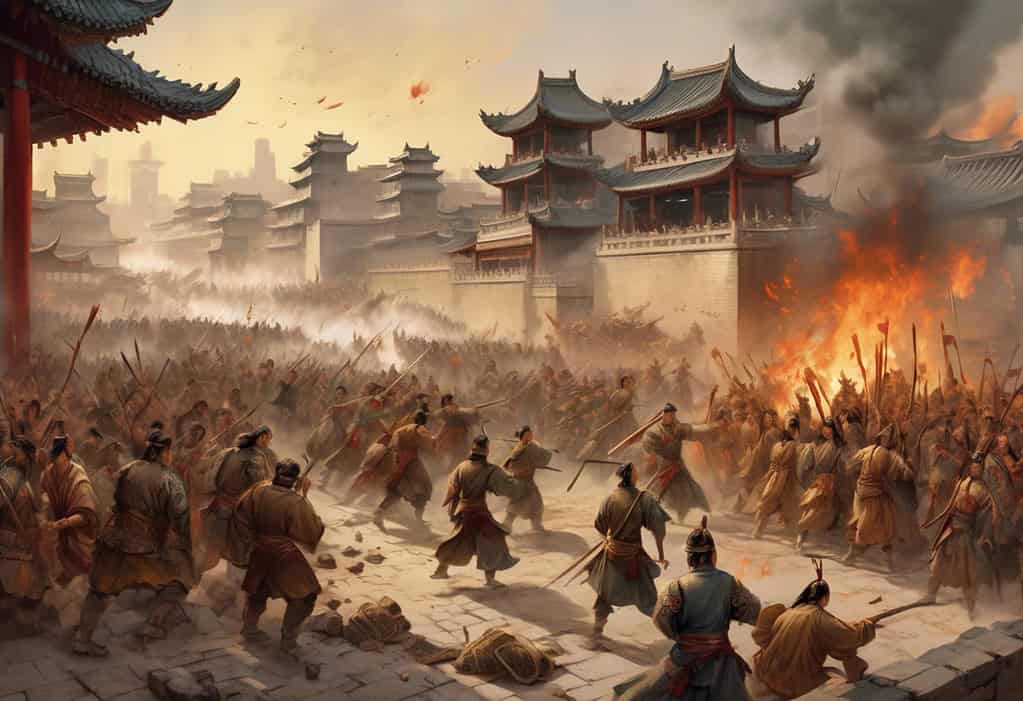The Five Dynasties and Ten Kingdoms Period lasted from 907 to 960 CE. It was a time of political turmoil and division in China. This period saw the rise and fall of multiple dynasties and kingdoms, leading to constant warfare and instability. The power struggle eventually paved the way for the reunification of China under the Song Dynasty.
Summary List
- The Five Dynasties and Ten Kingdoms Period was a chaotic time in Chinese history, marked by constant warfare and political instability.
- It lasted from 907 to 960 CE, with five dynasties ruling northern China and ten separate kingdoms ruling in the south.
- The period saw the rise of powerful warlords and the fragmentation of the Chinese empire into smaller states.
- Despite the turmoil, the period also saw advancements in art, culture, and technology, including the development of printing and gunpowder.
- The Five Dynasties and Ten Kingdoms Period eventually ended with the reunification of China under the Song Dynasty in 960 CE.
Games And Apps
Learning Modules
Zhu Wen’s Rebellion (907 CE)
In 907 CE, Zhu Wen, a former Tang Dynasty general, led a rebellion that overthrew the ruling dynasty and established his own regime known as the Later Liang Dynasty. Zhu Wen's rebellion marked a turning point in Chinese history, leading to a period of political turmoil and fragmentation.
I Want To Learn This!Li Keyong’s Uprising (908 CE)
In 908 CE, Li Keyong led a daring uprising against the oppressive rule of the Tang Dynasty in China. With his army of loyal supporters, he fought bravely for justice and freedom, inspiring hope in the hearts of the oppressed people. His legacy as a fearless rebel leader lives on in history.
I Want To Learn This!Huang Chao’s Rebellion (878-884 CE)
Huang Chao's Rebellion (878-884 CE) was a major uprising in China led by the rebel leader Huang Chao, who sought to overthrow the Tang dynasty. The rebellion caused widespread destruction and chaos, leading to the eventual downfall of the Tang dynasty and the establishment of the Later Liang dynasty.
I Want To Learn This!Founding of the Later Liang Dynasty (907 CE)
In 907 CE, the Later Liang Dynasty was founded by Zhu Wen, a military general who overthrew the Tang Dynasty. With a ruthless rise to power, Zhu Wen established a new imperial lineage that would shape the political landscape of China for years to come.
I Want To Learn This!Founding of the Later Tang Dynasty (923 CE)
In 923 CE, Li Cunxu, a military general, overthrew the previous ruling dynasty and established the Later Tang Dynasty in China. With a vision of restoring stability and unity to the region, Li Cunxu's reign marked a turning point in Chinese history, shaping the political landscape for years to come.
I Want To Learn This!Founding of the Later Jin Dynasty (936 CE)
In 936 CE, the Later Jin Dynasty was founded by Shi Jingtang, a military general who rebelled against the Tang Dynasty. With the goal of restoring stability and unity to China, Shi Jingtang's reign marked a new chapter in Chinese history, bringing about significant cultural and political changes.
I Want To Learn This!Founding of the Later Han Dynasty (947 CE)
After the fall of the Tang Dynasty, the Later Han Dynasty rose to power in 947 CE, led by the powerful military general Liu Zhiyuan. With a focus on restoring stability and unity to the war-torn region, the dynasty marked a new era of prosperity and cultural advancement in China.
I Want To Learn This!Founding of the Later Zhou Dynasty (951 CE)
In 951 CE, Zhao Kuangyin, a military general, founded the Later Zhou Dynasty after overthrowing the previous ruling family. Under his rule, the dynasty saw significant military victories and economic growth, solidifying its power in the region. This period marked a significant shift in Chinese history.
I Want To Learn This!Founding of the Wu Kingdom (907 CE)
In 907 CE, the Wu Kingdom was founded by Yang Xingmi, a military general who seized power in the chaotic aftermath of the fall of the Tang Dynasty. With a vision of restoring stability and prosperity to the region, he laid the foundation for a new era of rule in southern China.
I Want To Learn This!Founding of the Wuyue Kingdom (907 CE)
In 907 CE, the Wuyue Kingdom was founded in China by Qian Liu, a powerful warlord. With a blend of military prowess and political cunning, Qian Liu united the region under his rule, establishing a prosperous and culturally rich kingdom that would flourish for centuries to come.
I Want To Learn This!Founding of the Min Kingdom (909 CE)
In 909 CE, the Min Kingdom was founded in present-day Fujian province, China. Led by Wang Shenzhi, this powerful kingdom emerged as a key player in the region, expanding its territory and influence. Discover the intrigue, battles, and alliances that shaped the rise of the Min Kingdom in this captivating historical tale.
I Want To Learn This!Founding of the Chu Kingdom (907 CE)
In 907 CE, the Chu Kingdom was founded by Ma Yin, a former Tang Dynasty general. With strategic alliances and military prowess, Ma Yin conquered the region and established his own ruling dynasty. The founding of the Chu Kingdom marked a new era in Chinese history, shaping the future of the region.
I Want To Learn This!Founding of the Southern Han Kingdom (917 CE)
In 917 CE, Liu Yan declared himself emperor and established the Southern Han Kingdom in present-day China. Through strategic alliances and military conquests, he successfully expanded his territory and solidified his reign. The founding of the Southern Han Kingdom marked a significant chapter in Chinese history.
I Want To Learn This!Founding of the Southern Tang Kingdom (937 CE)
In 937 CE, the Southern Tang Kingdom was founded in China by Li Bian, who declared himself emperor after overthrowing the Later Tang Dynasty. This new kingdom would go on to flourish culturally and economically, leaving a lasting impact on the region's history and legacy.
I Want To Learn This!Founding of the Southern Jing Kingdom (921 CE)
In 921 CE, the Southern Jing Kingdom was founded by King Gao Pian, a former general of the Tang Dynasty. This new kingdom would go on to play a crucial role in shaping the political landscape of southern China, ultimately becoming a powerful force in the region.
I Want To Learn This!Founding of the Northern Han Kingdom (907 CE)
In 907 CE, the Northern Han Kingdom was established in China, marking a pivotal moment in the country's history. Led by Liu Min, the kingdom aimed to restore stability and unity after the fall of the Tang Dynasty. This period saw significant cultural and political developments that shaped the region for centuries to come.
I Want To Learn This!Founding of the Northern Zhou Kingdom (951 CE)
In 951 CE, the Northern Zhou Kingdom was founded by Emperor Guo Wei after overthrowing the Later Han Dynasty. With a desire to unite the northern regions of China, he established a powerful empire that would shape the future of Chinese history. Intrigue, betrayal, and conquest marked this tumultuous period of transition.
I Want To Learn This!Founding of the Northern Wei Kingdom (913 CE)
In 913 CE, the Northern Wei Kingdom was founded, marking a pivotal moment in Chinese history. As a powerful and influential dynasty, the Northern Wei Kingdom would go on to shape the political landscape of China for centuries to come. Discover the dramatic events that led to its establishment and rise to power.
I Want To Learn This!Founding of the Northern Qi Kingdom (936 CE)
In 936 CE, the ambitious general Gaozu declared himself the Emperor of the Northern Qi Kingdom, marking the beginning of a new era in Chinese history. With a mix of military prowess and political cunning, Gaozu established a powerful dynasty that would shape the region for centuries to come.
I Want To Learn This!












